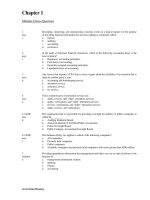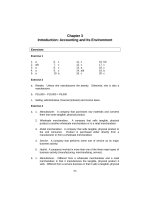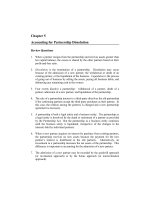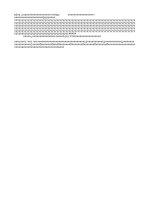Solution manual fundamentals of accounting by cabrera chapter 12 SM
Bạn đang xem bản rút gọn của tài liệu. Xem và tải ngay bản đầy đủ của tài liệu tại đây (147.31 KB, 16 trang )
Chapter 12
Financial Statements Analysis
Review Questions
1. A ratio is a mathematical expression of the relation of one figure to another.
The purpose in computing a ratio is simply to draw attention to this
relationship. The reader of a financial statement may observe, for example, that
sales were P12 million and accounts receivable P1 million. If he or she states
this relationship as a ratio—that is, that receivables turn over about 12 times
per year—the information may become more useful.
2. Measures of liquidity include the following (three required):
Current ratio (current assets divided by current liabilities).
Quick ratio (quick assets divided by current liabilities).
Working capital (current assets less current liabilities).
Net cash provided by operating activities (appears in a statement of cash
flows).
3. Current assets are expected to be converted into cash (or substituted for cash)
within one year or an operating cycle, whichever is the longer period of time.
The receivables of a company that regularly sells merchandise on 24- or 36month installment plans are current assets, because the collection of these
receivables is part of the company’s operating cycle.
4. The quick ratio is quick assets (cash, marketable securities, and receivables)
divided by current liabilities. Short-term creditors may consider the quick
ratio more useful than the current ratio if inventories consist of slow-moving
merchandise, or are unusually large in peso amount.
5. The debt ratio is computed by dividing total liabilities by total assets. It is
considered a measure of the long-term safety of creditors’ claims, rather than
a measure of short-term liquidity.
2
Chapter 12
6. Ratios and other measures used in evaluating profitability include (four
required):
Percentage change in net income from the prior year (peso amount of the
change divided by the amount in the prior year).
Gross profit rate (peso gross profit divided by net sales).
Operating income (revenue from primary business activities less the cost of
goods sold and operating expenses).
Net income as a percentage of net sales (net income divided by net sales).
Earnings per share (in the simplest case, net income divided by the number
of shares of share capital outstanding).
Return on assets (operating income divided by average total assets).
Return on equity (net income divided by average equity).
7. A large corporation may have thousands or even millions of individual
shareholders. The extent of each shareholder’s ownership of the business is
determined by the number of shares that he or she owns. Thus, the earnings
per share measurement helps shareholders relate the total earnings of the
business to their ownership investments.
8. If the company’s earnings are very low, they may become almost
insignificant in relation to share price. While this means that the p/e ratio
becomes very high, it does not necessarily mean that investors are optimistic.
In fact, they may be valuing the company at its liquidation value rather than a
value based upon expected future earnings.
9. A corporate net income of P1 million would be unreasonably low for a large
corporation, with, say, P100 million in sales, P50 million in assets, and P40
million in equity. A return of only P1 million for a company of this size
would suggest that the owners could do much better by investing in insured
bank savings accounts or in government bonds which would be virtually riskfree and would pay a higher return.
10. The current ratio would probably be higher during July. At this time the
amount of both current assets and current liabilities are likely to be at a
minimum, and the ratio of current assets to current liabilities is thus likely to
be larger. In general, it would be advisable for the company to end its fiscal
year as of July 31. At this time inventories and receivables will be at a
minimum; therefore, the chance of error in arriving at a valuation for these
Financial Statements Analysis
3
assets will be minimized, the work of taking inventories will be reduced, and
a more accurate determination of net income is probable.
Exercises
Exercise 1
(Pesos in
Millions)
a. (1) Quick assets:
Cash and short-term investments..................................................................
P 94.6
Receivables....................................................................................................
319.4
Total quick assets.......................................................................................
P414.0
(2) Current assets:
Quick assets [part a (1)]................................................................................
P414.0
Inventories......................................................................................................
144.6
Prepaid expenses and other current assets....................................................
64.0
Total current assets....................................................................................
P622.6
b. (1) Quick ratio:
Total quick assets (part a)..............................................................................
P414.0
Current liabilities...........................................................................................
260.2
1.6
to 1
Quick ratio (P414 P260.2)......................................................................
(2) Current ratio:
Total current assets (part a)...........................................................................
P622.6
Current liabilities...........................................................................................
260.2
2.4 to 1
Current ratio (P622.6 P260.2)................................................................
(3) Working capital:
Total current assets (part a)...........................................................................
P622.6
Less: Current liabilities..................................................................................
260.2
Working capital..........................................................................................
P362.4
c. By traditional standards, Shin Toys seems to be quite solvent. Both its quick
ratio and current ratio are well above rule-of-thumb levels, and its working
capital balance is substantial. As a large and well-established company, it is
quite possible that Shin Toys might be able to remain solvent even if its
liquidity measures became lower than normal.
4
Chapter 12
Exercise 2
Requirement (a)
(Pesos in thousands, except per share amounts)
WANSO, INC.
Statement of Earnings
For the Year Ended December 31, 2007
Net sales...............................................................................................................
P
8,790,506
Less: Cost of goods sold......................................................................................
5,642,910
Gross profit...........................................................................................................
P
3,147,596
Less: Operating expenses.....................................................................................
2,008,792
Operating income.................................................................................................
P1,138,804
Nonoperating items:
Interest revenue..........................................................................
P 31,594
Income taxes..............................................................................
(462,320)
(430,726)
Net earnings.........................................................................................................
P 708,078
Earnings per share................................................................................................
P3.16
Requirement (b)
(1) Gross profit rate:
Gross profit
Net sales
Gross profit rate (P3,147,596 P8,790,506)
(2) Net income as a percentage of net sales:
Net income
Net sales
Net income as a percentage of net sales
(P708,078 P8,790,506)
(3) Return on assets:
Operating income
Average total assets
Return on assets (P1,138,804 P4,686,136)
(4) Return on equity:
Net income
Average equity
P3,147,596
P8,790,506
35.8%
P 708,078
P8,790,506
8.1%
P1,138,804
P4,686,136
24.3%
P 708,078
P3,280,874
Financial Statements Analysis
Return on equity (P 708,078 P3,280,874)
5
21.6%
Requirement (c)
The sale of retail clothing represents the company’s primary source of revenue
from operations. Thus, interest revenue is a nonoperating source of revenue. To
include interest revenue in the gross profit computation would overstate both
gross profit and operating income.
Exercise 3
a. Percentage change in earnings per share:
In 2007:
Peso change from prior year (P9.06 – P6.16)..........................................................
+P2.90
Earnings per share in 2006.......................................................................................
P6.16
+47.1%
Percentage change (+P2.90 P6.16).......................................................................
In 2008:
Peso change from prior year (P10.96 – P9.06)........................................................
+P1.90
Earnings per share in 1987.......................................................................................
P9.06
+21.0%
Percentage change (+P1.90 P9.06).......................................................................
b. 2.5 to 1 (P27.50 market price divided by P10.96 earnings per share.)
c. The low p/e ratio, especially in the face of rapidly accelerating earnings,
indicates that investors expected Auto Max’s future earnings to decline from
the 2008 levels. It appears that the market was right, as earnings per share
levels for 2009 through 2013 were far below the 2008 level.
Note to instructor: All earnings per share figures shown in the problem have been
adjusted to reflect the effect of a 2-for-1 share split which occurred subsequent to
2008.
6
Chapter 12
Exercise 4
Requirement (a)
Return on assets
=
Operating income
Average total assets
P4,844
= P4,844 = 16.3%
= [(P29,096 + P30,392) 2]
P29,744
Requirement (b)
Return on equity
=
=
Net income
Average total equity
P698
= P698 = 7.6%
P9,236
[(P9,124 + P9,348) 2]
Requirement (c)
Equity figures shown in the balance sheet are reported at book value, not market
value. Thus, the increase in Happy Talk’s total equity for the year did not result
from an increase in the market value of the company’s shares.
Exercise 5
a. (1) Gross profit percentage:
2007: 32% [(P1,200,000 P816,000) P1,200,000]
2008: 34% [(P1,500,000 – P990,000) P1,500,000]
(2) Inventory turnover:
2007: 4 times (P816,000 P204,000 average inventory)
2008: 4.5 times (P990,000 P220,000 average inventory)
(3) Accounts receivable turnover:
2007: 6 times (P1,200,000 P200,000 average accounts receivable)
2008: 5 times (P1,500,000 P300,000 average accounts receivable)
b. There are three highly favorable trends. First, the growth in net sales from
Financial Statements Analysis
7
P1,200,000 to P1,500,000. This represents an increase of 25% (P300,000
increase, divided by P1,200,000 in the prior year). Next, the gross profit rate
increased from 32% in 2007 to 34% in 2008. Not only is Spectrum’s selling
more, but it is selling its merchandise at a higher profit margin. Finally, the
inventory turnover has increased, indicating that the company has increased
its sales without having to proportionately increase its investment in
inventories.
There is only one negative trend. The accounts receivable turnover rate has
declined. One question immediately should come to mind: Has Spectrum’s
liberalized its credit policies as part of its strategy to increase sales? If so, the
“slowdown” in the receivables turnover may have been expected and be no
cause for concern. On the other hand, if the company has not changed its
credit policies, it apparently is encountering more difficulty in collecting its
accounts receivable on a timely basis.
Exercise 6
a.
b.
c.
d.
e.
f.
g.
Current ratio: 3.6 to 1 (P1,080,000 P300,000)
Quick ratio: 1.4 to 1 (P420,000 P300,000)
Working capital: P780,000 (P1,080,000 – P300,000)
Debt ratio: 40% (P960,000 P2,400,000)
Accounts receivable turnover: 18 times (P5,580,000 P310,000)
Inventory turnover: 6.2 times (P3,348,000 P540,000)
Book value per share of capital stock: P24.00 (P1,440,000 60,000 shares)
Exercise 7
a.
Current assets:
Cash
Marketable securities
Accounts receivable
Inventory
Unexpired insurance
Total current assets
Current liabilities:
Notes payable
Accounts payable
P
95,200
350,080
460,900
359,200
9,000
P1,274,380
P
140,000
250,860
8
Chapter 12
Salaries payable
Income taxes payable
Unearned revenue
Total current liabilities
15,140
29,200
20,000
P 455,200
b. The current ratio is 2.8 to 1. It is computed by dividing the current assets of
P1,274,380 by the current liabilities of P455,200. The amount of working
capital is P819,180, computed by subtracting the current liabilities of
P455,200 from the current assets of P1,274,380.
The company appears to be in a strong position as to short-run debt-paying
ability. It has almost three pesos of current assets for each peso of current
liabilities. Even if some losses should be sustained in the sale of the
merchandise on hand or in the collection of the accounts receivable, it appears
probable that the company would still be able to pay its debts as they fall due
in the near future. Of course, additional information, such as the credit terms
on the accounts receivable, would be helpful in a careful evaluation of the
company’s current position.
Exercise 8
(Pesos in
Millions)
a.
Current assets:
Cash
Receivables
Merchandise inventories
Prepaid expenses
Total current assets
Quick assets:
Cash
Receivables
Total quick assets
b.
(1)
(2)
P 149.6
305.4
2,383.6
191.1
P3,029.6
P149.6
305.4
P455.0
Current ratio:
Current assets (part a)
Current liabilities
Current ratio (P3,029.6 P3,878.0)
P3,029.6
P3,878.0
0.8 to 1
Quick ratio:
Quick assets (part a)
Current liabilities
P455.0
P3,878.0
Financial Statements Analysis
Quick ratio (P455 P3,878.0)
9
0.1 to 1
(3)
c.
Working capital:
Current assets (part a)
P3,029.6
Less: Current liabilities
3,878.0
Working capital
P(848.4)
No. It is difficult to draw conclusions from the above ratios. Makati’s
current ratio and quick ratio are well below “safe” levels, according to
traditional rules of thumb. On the other hand, some large companies with
steady cash flows are able to operate successfully with current ratios lower
than Makati’s.
d.
Due to characteristics of the industry, supermarkets tend to have smaller
amounts of current assets and quick assets than other types of
merchandising companies. An inventory of food has a short shelf life.
Therefore, the inventory of a supermarket usually represents only a few
weeks’ sales. Other merchandising companies may stock inventories
representing several months’ sales. Also, supermarkets sell primarily for
cash. Thus, they have relatively few receivables. Although supermarkets
may generate large amounts of cash, it is not profitable for them to hold
assets in this form. Therefore, they are likely to reinvest their cash flows in
business operations as quickly as possible.
e.
In evaluating Makati’s liquidity, it would be useful to review the company’s
financial position in prior years, statements of cash flows, and the financial
ratios of other supermarket chains. One might also ascertain the company’s
credit rating from an agency such as Dun & Bradstreet.
Exercise 9
Requirement 1
a.
Net income
Less preference dividends
Net income remaining for ordinary (a)
This Year
P324,000
16,000
Last Year
P240,000
16,000
P308,000
P224,000
50,000
P6.16
50,000
P4.48
Average number of ordinary shares (b)
Earnings per share (a) ÷ (b)
10
b.
Chapter 12
Ordinary dividend per share (a)*
Market price per share (b)
Dividend yield ratio (a) ÷ (b)
P2.16
P45.00
4.8%
P1.20
P36.00
3.33%
This Year
P2.16
P6.16
35.1%
Last Year
P1.20
P4.48
26.8%
P45.00
P6.16
7.3
P36.00
P4.48
8.0
*P108,000 ÷ 50,000 shares = P2.16;
P60,000 ÷ 50,000 shares = P1.20
c.
Ordinary dividend per share (a)
Earnings per share (b)
Dividend payout ratio (a) ÷ (b)
d.
Market price per share (a)
Earnings per share (b)
Price-earnings ratio (a) ÷ (b)
Investors regard Metro Building Supply less favorably than other firms in the
industry. This is evidenced by the fact that they are willing to pay only 7.3
times current earnings for a share of the company’s stock, as compared to 9
times current earnings for the average of all stocks in the industry. If
investors were willing to pay 9 times current earnings for Metro Building
Supply’s stock, then it would be selling for about P55 per share (9 × P6.16),
rather than for only P45 per share.
e.
This Year
Last Year
Equity..........................................................................................................................
P2,150,000
P1,950,000
Less preference shares................................................................................................
200,000
200,000
Ordinary equity (a).....................................................................................................
P1,950,000
P1,750,000
Number of ordinary shares (b)...................................................................................
50,000
50,000
Book value per share (a) ÷ (b)....................................................................................
P39.00
P35.00
A market price in excess of book value does not mean that the price of a
stock is too high. Market value is an indication of investors’ perceptions of
future earnings and/or dividends, whereas book value is a result of already
completed transactions and is geared to the past.
Requirement 2
a.
This Year
Last Year
P 324,000
P 240,000
Net income..................................................................................................................
Financial Statements Analysis
11
Add after-tax cost of interest paid:
[P90,000 × (1 – 0.40)]............................................................................................
54,000
54,000
P 294,000
Total (a).......................................................................................................................
P 378,000
b.
Average total assets (b)...............................................................................................
P3,650,000
P3,000,000
Return on total assets (a) ÷ (b)...................................................................................
10.4%
9.8%
This Year
Last Year
P 324,000
P 240,000
Net income..................................................................................................................
Less preference dividends..........................................................................................
16,000
16,000
Net income remaining for ordinary
P 308,000
P 224,000
shareholders (a).......................................................................................................
Average total equity*..................................................................................................
P2,050,000
P1,868,000
Less average preference shares..................................................................................
200,000
200,000
Average ordinary equity (b)........................................................................................
P1,850,000
P1,668,000
*1/2(P2,150,000 + P1,950,000); 1/2(P1,950,000 + P1,786,000).
Return on ordinary equity (a) ÷ (b)
16.6%
13.4%
c. Financial leverage is positive in both years, since the return on ordinary
equity is greater than the return on total assets. This positive financial
leverage is due to three factors: the preference shares, which has a dividend
of only 8%; the bonds, which have an after-tax interest cost of only 7.2%
[12% interest rate × (1 – 0.40) = 7.2%]; and the accounts payable, which may
bear no interest cost.
Requirement 3
We would recommend keeping the stock. The stock’s downside risk seems small,
since it is selling for only 7.3 times current earnings as compared to 9 times
earnings for the average firm in the industry. In addition, its earnings are strong
and trending upward, and its return on ordinary equity (16.6%) is extremely
good. Its return on total assets (10.4%) compares favorably with that of the
industry.
The risk, of course, is whether the company can get its cash problem under
control. Conceivably, the cash problem could worsen, leading to an eventual
reduction in profits through inability to operate, a reduction in dividends, and a
precipitous drop in the market price of the company’s stock. This does not seem
likely, however, since the company can easily control its cash problem through
more careful management of accounts receivable and inventory. If this problem
12
Chapter 12
is brought under control, the price of the stock could rise sharply over the next
few years, making it an excellent investment.
Test Materials
Test Material 12-1
(Peso
Amounts in
Thousands)
a.
Current ratio:
(1)
Beginning of year (P108,260 P126,962)
0.85 to 1
End of year (P185,184 P166,714)
1.11 to 1
Working capital:
(1)
Beginning of year (P108,260 – P126,962)
P(18,702)
(2)
b.
d.
(2)
End of year (P185,184 – P166,714)
(1)
Return on average total assets:
Operating income
Average total assets [(P469,396 + P834,826) 2]
Return on average total assets (P152,282
P652,112)
(2)
Return on average equity:
Net income
Average equity [(P248,116 + P416,378) 2]
Return on average equity
(P88,304 P332,247)
P18,470
P152,282
P1,304,222
23%
P88,304
P332,247
27%
c. and e.
c. Box Office Video’s short-term debt-paying ability appears to be improving. In
the course of the year, the company’s current ratio has improved, and its
working capital has increased from a negative amount of more than P18 million
to a positive amount of more than P18 million (an P36 million turnaround).
Financial Statements Analysis
13
While Box Office’s solvency has been increasing and its current ratio at yearend exceeds that of Digicom, Box Office is not as good a credit risk. Box
Office and Digicom are both service companies. As a regional telephone
company, however, Digicom has an extremely reliable source of monthly
earnings and cash flows. Box Office, in contrast, offers a less essential service
and operates in a more competitive marketplace. As mentioned in this chapter,
major telephone companies often operate with current ratios of less than 1 to
1. Therefore, a current ratio of .9 to 1 does not indicate any specific financial
difficulties for Digicom. Unless Digicom were to encounter some very
unusual financial problems, it will always be viewed as a better credit risk
than (relatively) small companies engaging in highly competitive business
activities.
e. Box Office’s management appears to be utilizing the company’s resources in
more than a “reasonably efficient” manner. The company’s return on assets
and return on equity both are well above the company’s cost of borrowing
money, the “norms” in many industries, and the rates of return that investors
can safely achieve from, say, putting their money in a bank.
Test Material 12-2
Requirement (a)
(1) Inventory turnover:
Cost of Goods Sold, P3,510,000 = 5 times
Average Inventory, P702,000
(2) Accounts receivable turnover:
Credit Sales, P5,400,000
= 9 times
Average Accounts Receivable, P600,000
(3)
Total operating expenses:
Sales
Less: Cost of goods sold
Gross profit
Less: Interest expense (non-operating item)
Income taxes (non-operating item)
Net income
Operating expenses
P5,400,000
3,510,000
P1,890,000
P 90,000
168,000
318,000
576,000
P1,314,000
14
Chapter 12
(4) Gross profit percentage: Sales, P5,400,000 cost of goods sold, P3,510,000
= gross profit, P1,890,000. P1,890,000 P5,400,00 = 35%
(5) Return on average equity, P318,000 P1,590,000 = 20%
(6)
Return on average assets:
Operating income:
Sales
Cost of goods sold
Gross profit
Operating expenses
Operating income
Average investment in assets
Return on average assets (P576,000
P3,600,000)
P5,400,000
3,510,000
P1,890,000
1,314,000
P 576,000
P3,600,000
16%
Requirement (b)
Obtaining the loan will be desirable to stockholders because the return on
average assets (16%) is greater than the prospective rate of payment to creditors
(12%). In other words, the stockholders will gain from applying leverage, which
is a form of financing using fixed-return securities as capital.
Of course the assumption of long-term debt would increase the risk to the
stockholders. In the event of a business downturn, the earnings of the company
might fall far below the present levels and the company might be unable to meet
the interest payments on the loan, which could entitle the creditor to take control
of the company. Use of money borrowed at a rate of 12% will be beneficial to
stockholders if we can assume that the company will continue to earn more than
a 12% return on assets.
Test Material 12-3
a.
JH Corp.
(1) Working capital:
(P51,000 + P75,000 + P84,000 - P105,000)
P105,000
EH
Imports,
Inc.
Financial Statements Analysis
(P20,000 + P70,000 + P160,000 - P100,000)
P150,000
JH Corp.
(2) Current ratio:
(P51,000 + P75,000 + P84,000) P105,000
(P20,000 + P70,000 + P160,000) P100,000
2.5 to 1
1.2 to 1
(4) Number of times inventory turned over during the year:
(P504,000 cost of goods sold P84,000 inventory)
(P480,000 cost of goods sold P160,000 inventory)
6 times
Average number of days required to turn over inventory:
(365 days 6 times)
(365 days 3 times)
61 days
Average number of days required to collect accounts
receivable:
(365 days 9 times)
(365 days 8 times)
(6) Operating cycle:
(61 days + 41 days)
(122 days + 46 days)
b.
EH
Imports,
Inc.
2 to 1
(3) Quick ratio:
(P51,000 + P75,000) P105,000
(P20,000 + P70,000) P100,000
(5) Number of times accounts receivable turned over:
(P675,000 credit sales P75,000 accounts receivable)
(P560,000 credit sales P70,000 accounts receivable)
15
.9 to 1
3 times
122 days
9 times
8 times
41 days
46 days
102 days
168 days
Although EH Imports, Inc., has a large peso amount of working capital and
a higher current ratio, JH Corp. has the higher-quality working capital. The
quality of working capital is determined by the nature of the current assets
comprising the working capital and the length of time required to convert
these assets into cash. Over half of JH Corp.’s current assets consist of cash
and receivables. Most of EH Imports, Inc.’s working capital is inventory,
which is a less liquid asset. The computation of each company’s quick ratio
16
Chapter 12
shows that JH Corp. has highly liquid assets (cash and receivables) in
excess of its current liabilities, whereas EH Imports, Inc., does not.
JH Corp. is also able to sell its inventory and to collect its receivables
more quickly than EH Imports, Inc. JH Corp. requires only 61 days to sell
its average inventory, while EH Imports, Inc., requires 122 days. The
overall operating cycle for JH Corp. is over two months shorter than for
EH Imports, Inc. Thus, JH Corp. is able to convert its current assets into
cash more quickly than EH Imports, Inc.
A supplier should prefer selling P20,000 in merchandise on a 30-day open
account to JH Corp. rather than to EH Imports, Inc. JH Corp. clearly has a
greater potential for paying off this account when it becomes due.









